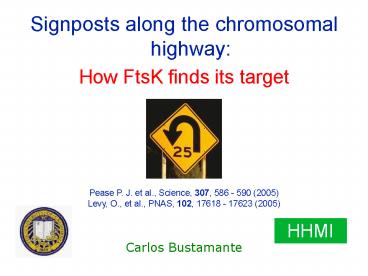Carlos Bustamante - PowerPoint PPT Presentation
1 / 22
Title:
Carlos Bustamante
Description:
septum during bacterial division. FtsK coordinates cell division (septum ... FtsK clears the septum of DNA3. Disruption of the ATPase domain of FtsK results in ... – PowerPoint PPT presentation
Number of Views:173
Avg rating:3.0/5.0
Title: Carlos Bustamante
1
Carlos Bustamante
Signposts along the chromosomal highway How
FtsK finds its target
Pease P. J. et al., Science, 307, 586 - 590
(2005) Levy, O., et al., PNAS, 102, 17618 - 17623
(2005)
HHMI
2
FtsK in bacteria2
- A membrane-bound translocase, localized at the
- septum during bacterial division.
- FtsK coordinates cell division (septum
closing) - with chromosome processes such as
- Chromosome segregation
- Dimer resolution
- Chromosome decatenation (with topo IV)
3
FtsK clears the septum of DNA3
At the end of replication in E. coli each
daughter cell must end up with a single and
complete circular chromosome. Yet, chromosomes
are not always properly segregated.
Disruption of the ATPase domain of FtsK results
in cells that are defective in chromosome
segregation
4
Dimer formation4
ds breaks during replication are repaired
via homologous recombination and can lead to
cross-overs. And an odd number of
cross-overs will generate a chromosome dimer
replication
dif
5
FtsK is required to activate dimer resolution via
Xer C/D5
Xer C/D bound to dif
FtsK
In E. coli this situation occurs 10-15 of the
time and it is lethal to the cell. Resolved by
Xer C/D recombinases that acts near ter, at a
site called dif FtsK moves towards the dif sites
bringing them together activating
XerC/D Genetic experiments showed that
insertion of l-DNA near dif disrupted dimer
resolution in an orientation-dependent manner.
6
The protein6
N-terminus with 4 transmembrane domains
C-terminus translocation function a, b and g
sub-domains
Oligomerization domain
We are using a construct consisting of the
C-terminus a 50 aa oligomerization domain from
the N-terminus
7
FtsK crystalizes as a hexameric ring
PaFtsKCDg
120 Å
30 Å
Massey, Lowe et al., Mol. Cell (2006)
60 Å 1.8 turns
8
Single molecule reeling assay8
Can FtsK work against a large load of
10-15pN? Can we mimic FtsKs role in clearing the
septum?
l DNA
Shortening occurs in bursts
Formation and expansion of a DNA loop
FtsK 30 - 100 nm and ATP 3 mM
9
FtsK is the fastest known translocase9
Activity occurs in bursts
Reverse translocation with similar rate loop
release
translocation rate 5.0 0.9 kbp/s
Tight distribution of velocities argues
that single complex is involved in each
burst
FtsK functions as a bi-directional motor
10
Direct visualization of FtsK on l DNA10
Above 100 nM the molecule aggregated and it
was possible to visualize particles that
bound and translocated along the DNA
- Independent verification of velocity (4.9
0.9 kb/sec). - Although occassionally they would change
direction, particles always moved in the
same overall direction. (75 out of 75
observations). - 3. Inverted their direction upon inverting the
orientation of the tether. - 4. The protein was able to work against forces gt
60 pN
optical trap
Looping lt 30 pN Transloc gt30 pN
11
How is directionality determined? Models for
directionality11
Loading orientation vs. Dynamic
rectification
12
What will be the directionality of FtsK on its
natural substrate?12
in vivo FtsK must move and efficiently find its
way towards dif
We constructed 3 different tethers we labeled L,
R and C
13
FtsK moves towards dif13
For L and R (15 out of 15) observations FtsK
moved towards the end closest to dif. C
oscillated back forth
FtsK is able to read the sequence of
the DNA as it translocates
Velocity 4.8 0.9 kbp/s
14
C-tether turn around14
A statistical analysis of these single molecule
observations Indicate that turnarounds occur at
specific points, and that they are
significantly more likely when moving away from
dif.
dif
F gt 30 pN
15
What is the sequence that directs FtsK?
An FRS (FtsK Recognition Sequence) should display
a significant skew on the E. coli chromosome
and must switch strands and orientation at dif.
Main idea Look for highly skewed sequences on
E. coli that change strand at dif within 15 kbp
on each side
16
Motifs
Selected candidates
Informatics skew analysis of the E. coli
chromosome at both sides of dif, yielded
initially nine motifs
GNAGGG GNGNAGGG CAGNNNAG CAGNNCAG CANNNATA CGNATA
AATANNNC AATNCG GTAANNNC
17
The informatics analysis shows GNGNAGGG
motif (its complement, or both) as the
top FRS (FtsK Recognition Sequence).
The probability that this skew occurred by
chance a 100 kb from dif is 1.7x10-57.
Result of the analysis17
Also see Bigot et al. EMBO J. (2005)
Skew 86 at 100kb 79 at 1000kb
Moreover, the skew of this sequence inverts at
dif. On average a GNGNAGGG sequence is found on
both sides of dif at a density of one every 300
bps.
18
Testing the FRS A bouncer experiment
Optical tweezers
6 kb (2 mm) spacer
Test sequence anti or iso orientation
41 kb lambda DNA antenna
FtsK
19
The anti-orientation with 5 repeats
20
The anti-orientation with 1 repeat
21
Summary of results
22
Conclusions
FtsK is a fast translocase, capable of
moving at rates of 5 kbp/s. The molecule
can form DNA loops and develop forces as high
as 60 pN. It is a bi-directional motor. Although
it can reverse its direction it moves along the
DNA in the same overall direction. FtsK
changes direction in response to sequences
oriented along the DNA in a skewed manner at
both sides of dif. The observed movements of
FtsK suggest a two-motor mechanism capable
of inverting its directionality in response to
periodically spaced sequences along DNA. We have
identified GNGNAGGG as the FRS sequence
which Upon encountered switches FtsK
translocation direction about 38 of the time.































